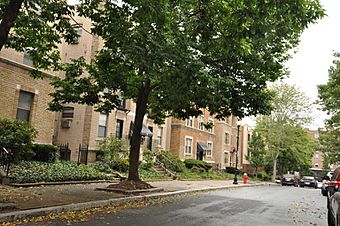Little Hollywood Historic District facts for kids
Quick facts for kids |
|
|
Little Hollywood Historic District
|
|
 |
|
| Location | Farmington Ave., Owen, Frederick and Denison Sts., Hartford, Connecticut |
|---|---|
| Area | 8 acres (3.2 ha) |
| Built | 1907 |
| Architect | Matthews, George H.; Et al. |
| Architectural style | Queen Anne, Shingle Style, Georgian Revival |
| NRHP reference No. | 82004423 |
| Added to NRHP | April 29, 1982 |
The Little Hollywood Historic District is a special area in Hartford, Connecticut. It is known for its many apartment buildings. Most of these buildings were built between World War I and World War II.
These apartments are found on Farmington Avenue, Owen, Frederick, and Denison Streets. They were built for single people looking for smaller homes. This was a new idea that became popular after World War I. The district was added to the National Register of Historic Places in 1982. This means it is an important historical place.
Contents
Exploring the History of Little Hollywood
The Asylum Hill neighborhood in Hartford was once a very fancy place. Rich families built beautiful homes and large estates there. But by the early 1900s, people started moving further away from the city center.
How Asylum Hill Changed Over Time
As people moved, Asylum Hill began to change. It became a place for middle-class families. The Little Hollywood area, near Nook Farm, started to develop before World War I. New apartment buildings were built on Farmington Avenue.
Building Boom: Owen, Frederick, and Denison Streets
The streets of Owen, Frederick, and Denison were developed between 1919 and 1923. Many local architects designed these buildings. George H. Matthews designed 16 of the 39 buildings in the area.
What Makes the Buildings Special?
The historic district has many brick apartment buildings. They are three or four stories tall. You can see them on the north side of Farmington Avenue, near Loraine Street.
Architectural Styles You Can See
Two important buildings are on the south side of Farmington Avenue, around Owen Street. These buildings show off different styles of architecture. You can see Renaissance Revival, Chicago School, and Jacobethan styles.
Differences in Street Designs
The buildings on Owen, Frederick, and Denison Streets are a mix of older and newer styles. The newer buildings, built after World War II, are not part of the historic district. The older buildings on these streets are simpler than the ones on Farmington Avenue, but they still have interesting designs.



